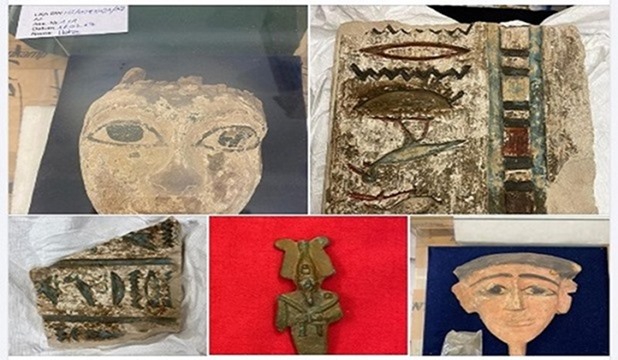Have you ever wondered what happens to cultural treasures that are taken from their countries of origin? The age-old debate surrounding the repatriation of artefacts has once again reared its head, with Egypt reclaiming a significant number of its historical treasures from Germany. In this intriguing case, 67 artefacts have been reclaimed, shining a spotlight on the importance of preserving and safeguarding cultural heritage. Let’s unravel the significance of this recent development and explore why such actions are essential in the context of global cultural heritage preservation.
The Significance of Reclaiming Artefacts
Reclaimed artefacts serve as a physical link to ancient civilizations, embodying the cultural and historical narratives of their people. For Egypt, a nation celebrated for its rich history and monumental archaeological sites, reclaiming artefacts is a matter of cultural pride and historical justice. These artefacts are more than mere objects; they hold immense cultural and symbolic value, representing centuries of tradition, art, and religious beliefs.
Why Germany Returned the Artefacts
The recent return of artefacts highlights the cooperative efforts between nations to address historical wrongs. Germany’s decision to return these objects is part of a growing trend where countries are recognizing the ethical imperatives of repatriation and acting on them. Collaborative diplomatic efforts, spearheaded by Egypt’s Ministry of Foreign Affairs and supported by their diplomatic missions, were key in achieving this milestone.
What Were the Artefacts?
The artefacts recovered signify a broad spectrum of ancient Egyptian history, each piece telling its own unique story. Among the collection is a bronze royal statue and several smaller statues known as shabti. The shabti statues were buried with the deceased to serve them in the afterlife, following ancient Egyptian customs. Also included are wall paintings and bronze statues of Osiris, revered as the god of the underworld and a central figure in Egyptian religious beliefs.
The Historical Context of the Artefacts
Many of these artefacts were originally removed from the tomb of a minister from the era of Bakenranef in Saqqara. Saqqara is one of Egypt’s most important archaeological sites, known for its pyramids and ancient tombs. Artefacts like mummified limbs, masks, and wall paintings not only illuminate the burial practices and aesthetic sensibilities of ancient Egyptians but also offer insights into their societal structures and religious beliefs.
Egypt’s Quest for Heritage Repatriation
The reclaiming of these artefacts is a part of Egypt’s broader initiative to return smuggled treasures to their rightful home. Egypt has been working diligently on this front, utilizing diplomatic avenues and legal mechanisms to recover cultural property illegally removed and sold to collectors and museums abroad.
Diplomatic Efforts and International Cooperation
Egypt’s strategy involves extensive cooperation between its Ministries of Foreign Affairs and Tourism and Antiquities. These bodies, along with Egyptian embassies worldwide, have intensified efforts to track down and recover artefacts. The collaboration signifies a global movement where countries are increasingly acknowledging the cultural sovereignty of nations over their historical artefacts and cooperating on issues of heritage repatriation.
Laws and Ethical Considerations
Repatriating artefacts isn’t just about diplomacy; it’s also embedded in international laws and ethical considerations. Many international conventions, such as the 1970 UNESCO Convention on the Means of Prohibiting and Preventing the Illicit Import, Export, and Transfer of Cultural Property, advocate for the return of cultural property to its countries of origin. Legal frameworks like these provide mechanisms to combat illegal trafficking and support the rightful return of cultural heritage.
Broader Implications for Cultural Preservation
The return of artefacts to Egypt underscores the importance of cultural preservation on a global scale. Heritage sites and objects face threats from illicit trade, conflicts, and environmental factors, making preservation an urgent concern. Repatriation initiatives highlight the need for countries to protect their heritage and educate the global community about the significance of their cultural narratives.
The Role of Museums and Cultural Institutions
Museums and cultural institutions play a critical role in supporting repatriation. By acknowledging the provenance of their collections and looking into the histories of the acquired objects, these institutions become active participants in cultural restitution. Many prominent museums are revisiting their collections to assess which artefacts can be rightfully returned, a move that stands to enhance their reputations and foster goodwill with originating countries.
Community Involvement in Cultural Preservation
For repatriation to have a lasting impact, it’s vital that local communities in countries like Egypt are involved in preservation efforts. Initiatives that engage community members in maintaining and showcasing their cultural heritage can foster a deeper appreciation and understanding of their history. Promoting cultural education and awareness ensures that these reclaimed artefacts are preserved not just physically, but also in the collective memory of the people.
Conclusion
Reclaiming artefacts is not merely about recovering what was lost; it’s about restoring cultural identity and heritage. It reflects a broader recognition of the rights of nations to their cultural legacies. The story of Egypt’s reclamation of 67 artefacts from Germany serves as a poignant example of the growing awareness and commitment to cultural preservation in the international arena. As the global community continues to grapple with issues of ownership and cultural heritage, such actions remind us of the importance of respecting and valuing the historical narratives of all civilizations.
In the end, the artefacts do more than fill museum displays—they connect us to the rich tapestry of human history and remind us of our shared cultural heritage. And that, in itself, is worth preserving.

